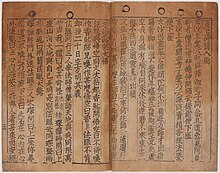
Back جيكجي Arabic Jikji Azerbaijani Jikji Catalan Čikči Czech Jikji CSB Jikji German Jikji Esperanto Jikji Spanish Jikji Basque جیکجی Persian
This article may require copy editing for grammar, style, cohesion, tone, or spelling. (May 2024) |
| Jikji | |
 Pages from the first book printed using type | |
| Korean name | |
|---|---|
| Hangul | 백운화상초록불조직지심체요절 |
| Hanja | |
| Revised Romanization | Baegun hwasang chorok buljo jikji simche yojeol |
| McCune–Reischauer | Paegun hwasang ch'orok pulcho chikchi simch'e yojŏl |
Jikji (Korean: 직지; Korean pronunciation: [tɕiktɕ͈i]) is the abbreviated title of a Korean Buddhist document whose title can be translated to "Anthology of Great Buddhist Priests' Zen Teachings".[1] Printed during the Goryeo Dynasty in 1377, it is the world's oldest extant book printed with movable metal type. UNESCO confirmed Jikji as the world's oldest metalloid type in September 2001 and includes it in the Memory of the World Programme.[2]
Jikji was published in Heungdeok Temple in 1377, 78 years prior to Johannes Gutenberg's acclaimed "42-Line Bible" printed during the years 1452–1455.[3][4] The greater part of the Jikji is now lost, and today only the last volume survives, and is kept at the Manuscrits Orientaux division of the National Library of France (BnF).[4] The BnF has hosted a digital copy online.[5]
Jikji Simche means, "If you look at a person's heart correctly through the Zen meditation, you will realize that the nature of the heart is the heart of Buddha.".[6]
- ^ Baegun hwasang chorok buljo jikji simche yojeol (vol.II), the second volume of "Anthology of Great Buddhist Priests' Seon Teachings", unesco.org, accessed June 2011
- ^ Memory of the World, unesco.org, accessed November 2009
- ^ Jordan, Nicole, ed. (2012). Michelin Green Guide South Korea. Michelin Guide. p. 387. ISBN 978-1907099694.
- ^ a b "Jikji: An Invaluable Text of Buddhism". The Korea Times. April 1, 2010. Retrieved February 9, 2017.
- ^ 백운화상초록불조직지심체요절. 白雲和尙抄錄佛祖直指心體要節 Päk un (1298-1374). Auteur du texte. Bibliothèque nationale de France, accessed October 18, 2020. 1377.
- ^ "직지심체요절". terms.naver.com (in Korean). Retrieved 2021-03-28.
© MMXXIII Rich X Search. We shall prevail. All rights reserved. Rich X Search